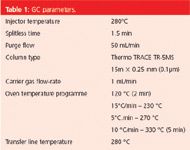Trace Analysis of Brominated Flame Retardants with High Resolution GC–MS
The Application Notebook
Polybrominated diphenyl ethers (PBDEs) are among the most important and widely used flame retardants. Recent legislation banned certain PBDE congeners.? EU directive 2003/11/EC prohibits the use of Penta-BDE and Octa-BDE for the member states of the European community.? Therefore, analysis of PBDEs have received increased interest as a result of their known toxicity.
Polybrominated diphenyl ethers (PBDEs) are among the most important and widely used flame retardants. Recent legislation banned certain PBDE congeners.1 EU directive 2003/11/EC prohibits the use of Penta-BDE and Octa-BDE for the member states of the European community.2 Therefore, analysis of PBDEs have received increased interest as a result of their known toxicity.
The most efficient trace analysis technique for BFRs proved to be high resolution GC–MS using an isotope dilution technique for quantification, especially suited for metabolism and accumulation studies in biological matrices.

Table 1: GC parameters.
Experimental Conditions
All measurements were performed on the DFS high resolution GC–MS coupled to a TRACE GC Ultra gas chromatograph with split/splitless injector. Samples were injected using the TriPlus autosampler.
GC column: Thermo TRACE TR-5MS, 15 m, 0.25 mm i.d., 0.1 μm film.
Injection volume: 1 μL of each sample.
GC temp. programme: see Table 1.
MS resolution: 10 000 (10% valley definition).
MID acquisition: one quantification and one ratio confirmation mass each, detailed MID set-up (see Table 1).
Internal standards: 13C labelled PBDE standards.
Analytical standards: Wellington Laboratories (not containing Octa- and Nona-BDEs).
Autotuning for the highest sensitivity was performed on PFK mass 480.9688.
PFK is also used as an internal mass reference providing a specific lock and calibration mass for each MID window (see Table 2). In every single MID measurement cycle, the instrument automatically performs an electric mass calibration taking these two reference masses as calibration points.

Table 2: MID set-up, MID lock mode (masses in brackets; optional second ratio mass for native PBDE).
Results
All congeners in the employed PBDE standard can be separated on the 15 m TRACE TR-5MS column (Figure 1) in the order of their bromination degree. The use of a short 15 m column with a thin film is recommended to analyse the thermolabile Deca-BDE.

Figure 1
The limits of quantification (LOQs) for the far higher boiling PBDEs are similar to those achieved for dioxin and PCBs. The quantification shows excellent linearity from the lowest fg range up to the highest standards (Figure 2).
Using the DFS high resolution GC–MS, polybrominated diphenyl ethers (PBDE) can be analysed with highest selectivity providing LOQs in the low femtogram range with the same analytical certainty as required in the analysis of dioxins and PCBs. For further information please visit www.thermo.com/dfs

Figure 2

Thermo Electron (Bremen) GmbH
Hanna-Kunath-Strasse 11, 28199 Bremen, Germany
tel. +49 421 5493-0
fax +49 421 5493-396
e-mail: hans-joachim.huebschmann@thermo.com
website: www.thermo.com
Reference
1. California Legislature Bill No. 302, Chaptered 11 August, 2003.
2. European Parliament and Council Directive 2002/95/EC on the Restriction of Hazardeous Substances (RoHS). European Parliament and Council Directive 2002/96/EC on Waist Electrical and Electronic Equipment (WEEE).
Analysis of Greenhouse Gases by Gas Chromatography
May 15th 2024This application note demonstrates the use of SCION's 8500GC system for the analysis of key greenhouse gases—carbon dioxide, methane, and nitrous oxide—in a single atmospheric air matrix. Highlighting the system's excellent sensitivity and repeatability, this method is crucial for understanding emission sources and combating climate change.
Analysis of DEHP in Drinking Water by HPLC-DAD
May 15th 2024This application note outlines a method for detecting low levels of 1,4-Dioxane, a likely carcinogenic compound, in drinking water using SCION GC-MS technology. It details the procedure for analyzing water samples spiked with 1,4-Dioxane, achieving excellent sensitivity and low detection limits, demonstrating the method's effectiveness for environmental monitoring.
Plant Protection Product Impurity Screening by GC-FID with GC-MS Confirmation
May 15th 2024This application note from SCION Instruments delves into the meticulous screening of impurities in plant protection products using GC-FID, with GC-MS for confirmation. It emphasizes the necessity of identifying and quantifying impurities to comply with regulatory standards in industries such as pharmaceuticals, food, and agriculture. The study specifically examines eugenol, showcasing how to determine significant impurities for regulatory submission. The approach integrates GC-MS and analytical standards, ensuring precise impurity identification and quantification critical for product approval.
